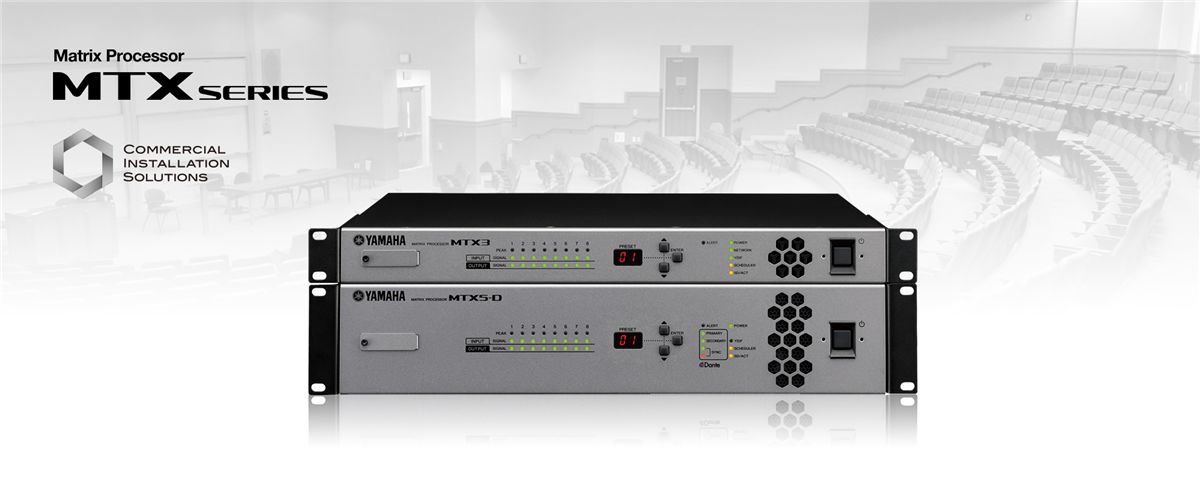MTX Series
Dedicated Software for Total Sound System Design
Central Management of Multiple Sound Systems from a Single PC
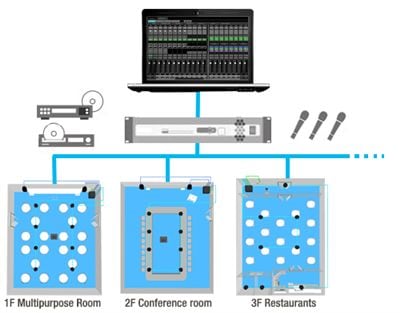
MTX-MRX Editor is a software application that is dedicated to the setup and management of sound systems built around the MTX and MRX series signal processors. It can mix audio from microphones, CDs, MP3 and WAV files, deliver different content to multiple zones, set up timer-activated music playback and announcements, and much more. MTX-MRX Editor makes it easy to manage and distribute sound that is optimized for separate areas of a store or facility from a single computer.
Centralized management of multiple network systems with Single PC
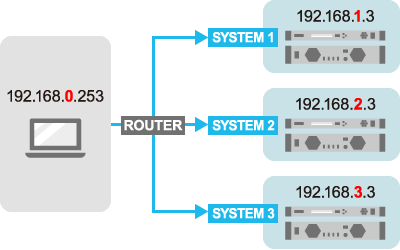
Furthermore, in Ver 3.2, for example, in multiple facilities such as amusement parks and shopping malls, it is possible to manage multiple areas separately on multiple subnets for each zone by a single PC.
Various parameters can be controlled from MTX-MRX Editor
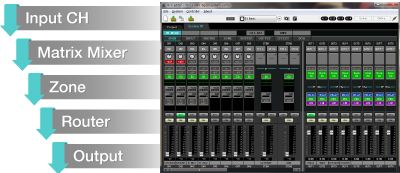
The MTX-MRX Editor software facilitates sound system design with a workflow that simulates standard installation procedure. An easy-to-use wizard lets you start by arranging the devices to be used in the desired layout, then processing components can be added wherever needed. MTX series matrix processors, EXi8 input expanders, EXo8 output expanders, XMV series power amplifiers, and DCP digital control panels can be added according to the needs and scale of the application. The MTX-MRX Editor provides comprehensive, intuitive tools for designing sound systems from input to output.
Input Ch
By selecting GAIN/HPF/EQ you can adjust 3-Band PEQ settings for each input channel, as well as each channels' High Pass Filter. GATE/COMP sets Gate and Compressor parameters and FBS/AGC features feedback suppressors that eliminate acoustic feedback, as well as the Auto Gain Control function that maintains a constant output level with input signals that vary in level.
Reverb
Reverb effects add simulated reverberation to the source sound.
MTX has 4 types of Reverb effects.Reverb Hall, Reverb Stage, Karaoke Echo, Vocal Echo.
FBS
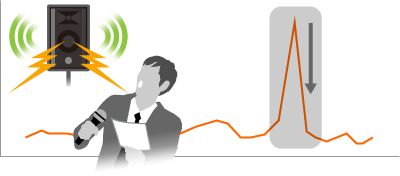
A Feedback Suppressor or FBS, is a function that prevents the unpleasant acoustic feedback that occurs when sound from a speaker is picked up by a mic and reamplified.
MTX features two types of FBS, Fixed and Dynamic. Fixed is ideal for installations where the microphones do not move and where the problem frequencies remain the same. If microphones are constantly moving then Dynamic FBS is more suitable as it can constantly update the settings to eliminate feedback.
AGC
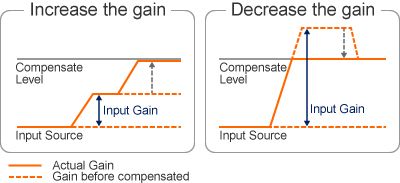
AGC (Auto Gain Controller) is a function that automatically compensates the gain according to the input level, keeping a constant output level for an incoming signal whose level is changing. This can be very useful when there are people speaking at different levels or there are background music sources at different levels and there is no technician available to make manual adjustments. The AGC will smooth the output levels making the listener's experience more pleasurable.
Dugan Automixer
The Dugan Auto Mixer is an advanced algorythm designed to manage and optimize the input gain of multiple microphones that are being used for unscripted speech. Having a number of microphones switched on at the correct level for speech can introduce feedback in the system if there is no engineer available to make adjustments. The Dugan Automixer automatically and seamlessly provides gain to a microphone when one person is speaker or shares it amongst two or more speakers mics, thus eliminating the likelyhood of feedback.
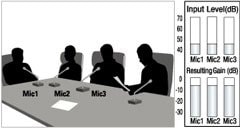
1) When no one is talking
When no one is talking, the input level on all microphones is lowered, and the gain levels are set uniformly. At this time, rather than muting each microphone, the gain is distributed between three microphones, so that the total gain remains constant.

2) When one person is talking
When one person speaks, the gain of that microphone instantly rises to 0 dB, and the gain of the other two microphones is lowered. The same thing happens when a different person speaks.

3) When multiple people are speaking
When two people speak simultaneously, the gain level is automatically distributed between the two microphones so that the total gain remains constant, and the gain of the remaining microphone is lowered.
Matrix Mixer
In the matrix mixer, the input channels and output buses are arranged in a checkerboard configuration. You can adjust the group balance for each output bus, or use the faders to adjust the signal from all input channels to a specific matrix bus when Sends On Faders mode is enabled.
The signal from the matrix mixer is sent to 8 units of Priority Processor. Here, you can make detailed adjustments to the parameter settings of the Ducker function as well the Ambient Noise Compensator.
Zone
A zone is an individual space or room within an audio installation that can be independantly treated and controlled. For example, a zone could be a separate area within a restaurant or a second floor within a retail store.
Priority Ducker
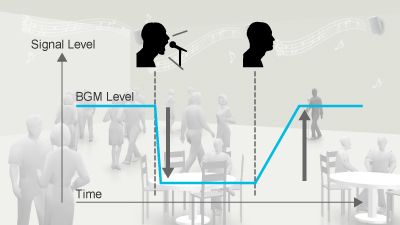
A Priority Ducker is a function used to automatically attenuate a zone's output level by a specified amount when the signal from a separate sound source exceeds its threshold. For example, it could be used to reduce the background music level when important emergency announcements are made so as to maximise intelligability.
ANC
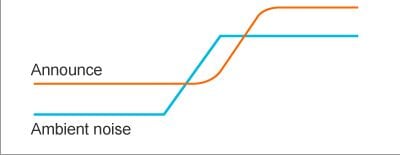
An ANC or Ambient Noise Compensator will adjust system gain to compensate for fluctuating background noise levels. A typical example would be at a party when the ambient noise becomes so loud that music or announcements can no longer be heard. The ANC will raise the system volume to compensate.
Router
Once a zone has been created inside MTX, the Router page can then be used to patch that zone to any of the outputs in the system. The router also contains an oscillator that can be used to test the audio system.
Output
After Priority Processor settings have been applied, signals are sent to output channels through the Router. Each output channel is equipped with a 4 Band PEQ, Delay and Speaker Processor. The Speaker Processor has stored presets for a range of Yamaha speakers allowing you to easily select the optimum settings for the speakers in your system. Settings for 4-Band PEQ and Delay can also be adjusted to match the audio output with the acoustic characteristics of various installation environments.
Speaker Processor
The Speaker Processor algorithm contains a range of specialist parameters to tune the speakers in the installation with their environment. These include a crossover for bi-amped speaker systems that offers a choice of specialist filters and polarity adjustment. There is also signal delay, a six band parametric equaliser for fine adjustment and a limiter to protect your speakers.

